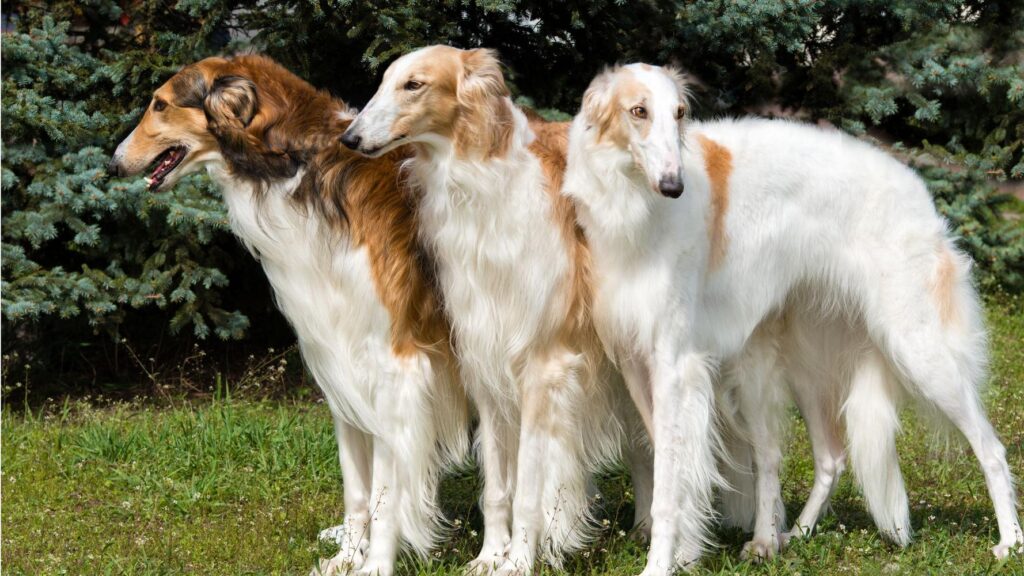All About Borzoi

All About Borzoi:- Among the most stunningly beautiful of all dog breeds, the aristocratic Borzoi is renowned for its friendly nature. When in full stride, this noble hound combines strength, elegance, and reaching speeds of 35 to 40 miles per hour.
Borzoi are large, graceful sighthounds. Mature males stand at least 28 inches at the shoulder and weigh between 75 to 105 pounds, with females being slightly smaller. Beneath their luxurious, silky coat, their build follows the ancient Greyhound design. Originally known as the Russian Wolfhound, Borzoi were bred for speed and endurance to chase and subdue their fierce wolf prey.

Though they can be somewhat stubborn in their quiet, catlike way, Borzoi respond best to training that is patient, consistent, and good-humored. They make affectionate family companions, but their dignified nature means they might not fully engage in roughhousing. Their strong chase instinct is triggered by the sight of a running cat or squirrel, so a securely fenced area is essential for their exercise and safety.
Characteristics of the Borzoi
Similar to the greyhound, the borzoi is known for its even-tempered, calm, and quiet nature, complemented by its graceful and elegant demeanor. While they are devoted and loving family companions, borzois aren’t typically inclined to engage in rough play with children due to their dignified disposition.
They might be reserved around strangers but are notably affectionate with their families and familiar individuals. Due to their strong prey drive and natural instincts for hunting and chasing, borzois might not always adapt well to homes with other pets. Ideally, they should be introduced to other animals while still puppies to ensure a smoother transition.
Food & Diet Requirements
Borzoi, being large dogs, have higher food requirements compared to most breeds. To prevent bloat—a condition they’re prone to—meals should be divided into smaller, more frequent servings throughout the day. Additionally, avoid rigorous exercise around mealtimes to further reduce the risk of bloat.
An adult Borzoi typically needs between 3 and 4 cups of high-quality food daily. Keep in mind that Borzoi puppies will need more food due to their rapid growth. Since Borzoi can be selective eaters, collaborating with your veterinarian to choose a nutritious food that your dog enjoys is crucial for their overall health and well-being.

How Much Should You Feed a Borzoi?
Start by following the feeding guidelines on your dog food package, which are based on your dog’s weight. However, a Borzoi’s health, activity level, and lifestyle also influence their dietary needs. For personalized advice, consult with your veterinarian to determine the ideal amount of food for your Borzoi.
Borzoi are large dogs with a lean, delicate build, so while they do require a substantial amount of food, it’s important not to overfeed them. Excessive food can lead to bloat, a common health issue in Borzoi.
Grooming
The Borzoi has a distinctive coat with a unique texture and distribution, featuring a frill around the neck and feathering on the hindquarters and tail. Due to its long, silky fur, this breed sheds frequently and requires brushing every couple of days with a pin or slicker brush and/or comb to manage loose hair and dirt. Additionally, the Borzoi experiences a heavier shedding period during the summer and fall, necessitating more frequent grooming.
Routine care includes regular baths and nail trims. Don’t forget to clean the ears and teeth consistently to maintain overall health. The Borzoi is a giant breed, with males standing at least 28 inches tall and weighing between 75 and 105 pounds. Females should be at least 26 inches tall and weigh between 60 and 85 pounds.
Given their size, Borzois require ample space to thrive. While a grand palace isn’t necessary, this breed might not be the best fit for smaller homes or apartments. It’s important to carefully consider your living situation before bringing a Borzoi into your home.

Did Borzoi Really Hunt Wolves?
Wolf hunting in Russia was as much about ceremonial grandeur as it was about the pursuit of prey, reflecting a ritualistic tradition with almost medieval flair. From Perchino, huntsmen dressed in the Grand Duke’s distinctive green livery and mounted on cushioned Cossack saddles set out from the hunting lodge. Each huntsman led a team of Borzoi, typically comprising two males and one female, or a pair and a single dog, carefully matched in size and color.
Their goal was to reach the shaded groves scattered across the steppe-like prairie. Trailing them were packs of foxhounds, a mix of English and Russian breeds, accompanied by huntsmen in red tunics wielding whips.
Once the huntsmen were in position and the grove was fully encircled, the hunting horn sounded, signaling the start of the hunt. The sharp cracks of whips urged the foxhounds into the underbrush, driving the wolf from its hiding spot. As the wolf bolted, the nearest horseman would spur his steed and release his Borzoi.
The Borzoi, charging with fierce speed, would soon catch up to the wolf, bringing it down with a coordinated attack. The aim was for the dog to grab the wolf by the neck, just under the ear, and hold on until the hunter arrived. The hunter would then dismount and either finish off the wolf with a dagger which the wolf would instinctively grasp. The captured wolf was then muzzled, transported to Perchino, where it would be used to train the next generation of wolf-hunting Borzoi.
Also Read:-




